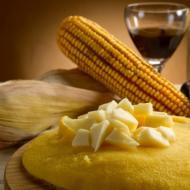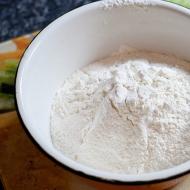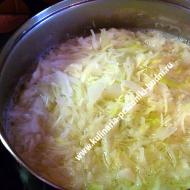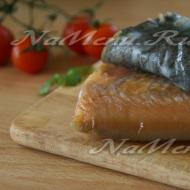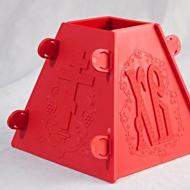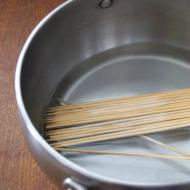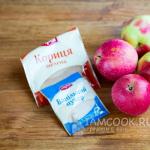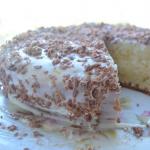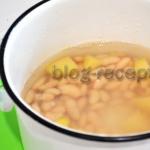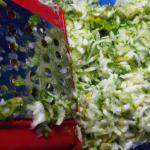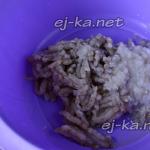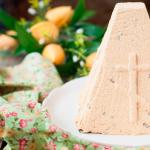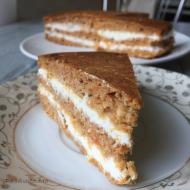
Recipes for making mamaliga from corn grits. Delicious and healthy mamalyga made from corn grits. What is this porridge eaten with?
Corn grits mamalyga is a very healthy, satisfying, nutritious dish. Since ancient times, this cereal has been considered a product that replaces bread. Before corn was brought in, hominy was made from millet. But with the advent of corn, millet was no longer used, since hominy comes out of corn flour much tastier, and moreover, it is more nutritious.
Corn grits mamalyga is a very healthy, satisfying, nutritious dish
Corn porridge is very high in calories and filling.
Contains many vitamins: retinol, thiamine, riboflavin, niacin, pyridoxine, folic acid, tocopherol, biotin. It also contains minerals: calcium, iron, magnesium, potassium, sodium, phosphorus. So this is a mess:
- has a beneficial effect on the body;
- improves digestion;
- cleanses the body of waste and toxins;
- helps reduce cholesterol levels;
- has a beneficial effect on the cardiovascular system;
- improves the condition of hair, skin, nails;
- stabilizes the functioning of the nervous system;
- gives strength, invigorates, improves performance and mood.
Mamalyga - porridge made from corn grits (video)
Mamaliga recipes
There are a large number of hominy recipes. It is prepared in different countries. In Italy there is a dish called polenta. This is also a type of mamalyga. Only the final dish is not as thick as ours. Georgians cook gomi, Romanians have mamaliga.
Corn grains are crushed and cut into pieces of different sizes. There are 1st, 2nd, 3rd, 4th grades of grain grinding, and the 5th is flour. In different countries, many tasty and nutritious dishes are prepared from corn grits of a certain type.
 Since ancient times, corn grits have been considered a product that replaces bread.
Since ancient times, corn grits have been considered a product that replaces bread. This is the national dish of Moldova. Porridge is prepared only in thick-walled cast iron dishes. Use cereal, water, salt. The cereal should be finely ground or even corn flour (grade 5). The ratio of cereal and water should be equal to 1: 3. When the water boils, add salt and sprinkle corn flour in a thin stream. It must be stirred constantly to prevent it from burning. To do this, place a wooden rolling pin in the center of the cauldron. The porridge should simmer gently for 25-30 minutes, then reduce the gas or reduce the heat to a minimum, continue cooking until the liquid has completely evaporated and until the desired thickness is achieved. At the same time, the porridge should not stick to the rolling pin. It is pulled out and cut into pieces using a thick thread. To do this, the thread is picked up from below and cut from the bottom up, crosswise.
Traditionally, Moldovans eat it with their hands. Season with butter and sour cream.
It is customary to eat this porridge with sour cream, cottage cheese, and cheese. Can be enjoyed with herbs, vegetables, bacon, eggs, mushrooms. It depends on taste preferences or national traditions. It is eaten instead of bread with many dishes.
The recipe for making mamalyga is budget-friendly. You will need little money for the porridge itself. But to season it with something special, you will have to allocate a certain amount.
It will be difficult to prepare the dish, since you will have to stir it for a long time so that lumps do not form. The more often you cook porridge, the faster your hand will get used to physical activity.

Using another method, you can cook it with milk:
- To do this, you need to prepare a glass of milk, 2 glasses of water, 2 glasses of finely ground cereal, salt, butter (50 g), about 400 g of lard with streaks of meat, and sheep cheese.
- Pour milk into a cauldron or thick-walled pan and bring to a boil. Pour water into it. Boil again. Just a little salt.
- When foam appears in the liquid, add cereal or corn flour in a thin stream.
- The cereal remains in the center of the dish, no need to mix. It is necessary to reduce the heat to a minimum and wait until it swells.
- The croup is swollen. Now you need to move the pan to the table. Take a masher and start kneading the porridge so as to catch and mash all the lumps. It is necessary to mix it thoroughly, turning it over, prying it well from the walls and bottom, there should be no dry missing lumps of cereal left. At first the porridge will be wet and sticky. But gradually it will absorb all the moisture and become thick.
- Then you need to add a piece of butter, then the porridge will become more elastic, it will be easier to form sausages from it.
- Next, you need to put the pan back on the stove over the lowest heat. Let the porridge steam for about 15 minutes, remove the lid to allow the liquid to evaporate.
- The resulting hominy should be thick, steep, dense.

How to quickly cook corn porridge (video)
Mamaliga in Georgian
This dish is also popular in Georgia. Mamalyga in Georgian is called gomi. It is often used instead of bread. Store-bought corn is not suitable for this dish. At the market, if you ask for cereal for gomi, they will definitely sell what you need. Usually these are two types of cereals - corn flour and coarse cereals.
 There are a large number of hominy recipes. It is prepared in different countries
There are a large number of hominy recipes. It is prepared in different countries Recipe for hominy made from corn flour and grits grade 3-4:
- Pour cold water into a saucepan or cauldron. First carefully pour the coarse chaff into it, then the flour. You need to stir constantly to avoid lumps. You need to take less flour than cereal.
- Afterwards, place the container on medium heat and cook for 2 hours. It is necessary to constantly grind and stir the mass thoroughly throughout the cooking, preventing the flour and cereal from clumping.
- When the water has boiled away and the porridge has lost the taste of raw flour, you can remove the dishes from the stove. The porridge will come out thick, dense, without lumps.
- Serve it on a plate with 2-3 pieces of suluguni cheese, feta cheese, and Adyghe cheese inside. They eat porridge with their hands.
- Gomi can be served with other dishes - satsivi, kharcho, shurpa. Only each dish must be in a separate plate; they cannot be mixed.

By experimenting, you can learn how to cook hominy, select the proportions, feel the readiness of the porridge, and then the cooked dinner will always delight your family and guests. There are a large number of recipes for the dish. It is distributed all over the world.
What is hominy and how can it be prepared? This dish is traditional in Georgia and is a very thick corn porridge. It is still used instead of bread in the western regions of Georgia. Initially, hominy was prepared from millet – Italian millet. A similar corn dish is extremely popular and loved among Moldovans and Romanians. In addition to the fact that hominy is extremely tasty and original, it is quite healthy, so it’s worth learning the step-by-step recipe for its preparation.
This dish can be considered unique, since salt, flour, cornmeal or grits, pork fat, and water are used to prepare it. When Georgian mamalyga is ready, it can be eaten like bread or porridge. Many women who live in Georgia have been making this delicacy for a long time. It is important to note that mamalyga goes well with cottage cheese, cheese, a variety of syrups and sauces. There are many ways to serve corn delicacy, each of which can surprise you with a new and very original taste.
If you use the traditional recipe for Georgian mamaliga, then you will need a thick-walled cauldron for cooking. To stir the dish while cooking, you do not need to use a spoon; for this you will need a thin rolling pin.
Despite many years of tradition regarding the method of preparing mamalyga, modern women have gotten used to preparing the dish in an ordinary saucepan. No one argues that this dish will differ from the classic Georgian mamaliga. However, your household will not be able to tear themselves away from the next portion of the corn delicacy. It is important to note that the total cooking time may take at least one hour.
Ingredients
To prepare Georgian mamaliga you will need the following ingredients:
Preparation
1. Prepare all the necessary products, as well as equipment that may be needed during the cooking process. First of all, this is a saucepan, two plates and a frying pan. Place a frying pan on the stove and place pre-chopped lard in it. It is very important that the fat is rendered out of it.

2. At this time, you can take a saucepan and pour 3 cups of purified water into it, add ½ teaspoon of fine salt. At this stage, a tablespoon of melted fat is added and the pan is sent to the stove.

3. Add corn grits after the water heats up but does not reach a boil. If desired, the cereal can be replaced with corn flour, it all depends on your desires and taste preferences.

4. Then you need to follow certain instructions so that the Georgian mamalyga turns out correctly. First, you need to stir the contents of the pan periodically. After the cereal swells, you need to stir constantly without stopping. Often Georgian women use a wooden spatula or rolling pin for this. If you don’t have such utensils in your kitchen, don’t despair; you can use a regular spoon. The only condition is to mix without stopping until you get a thick and viscous consistency, reminiscent of dough.

5. Transfer the finished hominy to a plate, using a spoon, smooth the surface of the dish.
6. Cut any cheese offered and decorate the dish. The main highlight is that the porridge is still hot, so the cheese will begin to melt and permeate the hominy with its aroma and taste.

Today I will talk about my favorite dish, which is a decoration for any table, be it a holiday or just an everyday family lunch.
Gomi- the highlight of the program is the main character of today's topic. Gomi, also known as mamalyga, is a Georgian porridge-like dish with cheese (usually suluguni, although you can take any: smoked suluguni, Imereti or any other pickled one)
What do you know about hominy? Do you like it? Have you tried it? Have you cooked it?
In my family Gomi I cook without waiting for any holidays. This is a completely self-sufficient dish. Cheese, vegetables and wine, this is how we simply get a tasty and satisfying lunch.

If you want to learn how to cook Gomi, + also learn how to choose the right corn flour - welcome to the cat.
Gomi- the dish is simple in composition, all you need: high quality corn flour

And coarsely ground corn grits a + cold water.

I cook gomi in a cast iron pot like this (and I recommend it to you - since this is the most suitable utensil for these purposes).

So, we figured out what to cook from and what to cook in. Now the only thing left to do is choose correct flour. I learned this experience from my husband Gio. We don’t buy it in bags, but go straight to the market and there is simply a huge assortment there. My eyes run wide, it seems like everyone has the same, every seller praises his product... But, Flour is different from flour. So, we go to the counter (flour in Georgian markets is sold in heaps), just pinch it with two fingers (from above) and squeeze it tightly with your fingers... Good flour after such manipulations will not crumble, it will remain in the same position. I have The photo shows this clearly.

If the flour has passed such a test control, then we can safely buy coarsely ground corn grits from the same seller (usually sold together in separate piles).
My recipe Gomi designed for this boiler (see photo above, capacity about 3 liters)
1 kg - coarse corn grits
1.5 kg - corn flour (with reserve)
We start by rinsing the corn grits very well. We place the prepared grits on the bottom of the cast iron pot.

Pour cold water to 2/3 of the height of the boiler. Cover with a lid and set to cook over medium heat. Boil the cereal well - time from 40 minutes to 1 hour.
When the cereal is well cooked, it remains liquid. Now it’s the turn of the flour. Add it in portions (one glass at a time). This must be done quickly, stirring it intensively.
To cook gomi, they use a special wooden spatula...
It will take less flour than cereal. I can’t say exactly how many glasses of flour you will need in your case, everyone should be able to determine the thickness of the flour themselves.
The main thing is not to pour it right away:.let the flour boil for 15-20 minutes...Then add it again.Cook - stir and add more if necessary.
The difficulty of cooking gomi lies in only one thing - you need to exert physical force and constantly stir (your hands get very tired when you are not used to it, but with experience you no longer notice it).
So, how to determine readiness?
1. Stick a wooden spatula into the gomi, it should not fall, it remains in the same position.
2. A crispy crust will form along the edge of the cauldron (see photo)

The total cooking time for gomi (in my case) is about 2 hours.
Gomi is traditionally laid out on portioned plates, with 2-3 pieces of cheese for each serving.
The cheese melts wonderfully in the hot “porridge” and we end up with such a viscous piece
Today I will talk about my favorite dish, which is a decoration for any table, be it a holiday or just an everyday family lunch.
Gomi- the highlight of the program is the main character of today's topic. Gomi, also known as mamalyga, is a Georgian porridge-like dish with cheese (usually suluguni, although you can take any: smoked suluguni, Imereti or any other pickled one)
What do you know about hominy? Do you like it? Have you tried it? Have you cooked it?
In my family Gomi I cook without waiting for any holidays. This is a completely self-sufficient dish. Cheese, vegetables and wine, this is how we simply get a tasty and satisfying lunch.

If you want to learn how to cook Gomi, + also learn how to choose the right corn flour - welcome to the cat.
Gomi- the dish is simple in composition, all you need: high quality corn flour

And coarsely ground corn grits a + cold water.

I cook gomi in a cast iron pot like this (and I recommend it to you - since this is the most suitable utensil for these purposes).

So, we figured out what to cook from and what to cook in. Now the only thing left to do is choose correct flour. I learned this experience from my husband Gio. We don’t buy it in bags, but go straight to the market and there is simply a huge assortment there. My eyes run wide, it seems like everyone has the same, every seller praises his product... But, Flour is different from flour. So, we go to the counter (flour in Georgian markets is sold in heaps), just pinch it with two fingers (from above) and squeeze it tightly with your fingers... Good flour after such manipulations will not crumble, it will remain in the same position. I have The photo shows this clearly.

If the flour has passed such a test control, then we can safely buy coarsely ground corn grits from the same seller (usually sold together in separate piles).
My recipe Gomi designed for this boiler (see photo above, capacity about 3 liters)
1 kg - coarse corn grits
1.5 kg - corn flour (with reserve)
We start by rinsing the corn grits very well. We place the prepared grits on the bottom of the cast iron pot.

Pour cold water to 2/3 of the height of the boiler. Cover with a lid and set to cook over medium heat. Boil the cereal well - time from 40 minutes to 1 hour.
When the cereal is well cooked, it remains liquid. Now it’s the turn of the flour. Add it in portions (one glass at a time). This must be done quickly, stirring it intensively.
To cook gomi, they use a special wooden spatula...
It will take less flour than cereal. I can’t say exactly how many glasses of flour you will need in your case, everyone should be able to determine the thickness of the flour themselves.
The main thing is not to pour it right away:.let the flour boil for 15-20 minutes...Then add it again.Cook - stir and add more if necessary.
The difficulty of cooking gomi lies in only one thing - you need to exert physical force and constantly stir (your hands get very tired when you are not used to it, but with experience you no longer notice it).
So, how to determine readiness?
1. Stick a wooden spatula into the gomi, it should not fall, it remains in the same position.
2. A crispy crust will form along the edge of the cauldron (see photo)
Gomi is corn porridge. In the old days it was prepared from chumiza. And since the end of the 19th century, corn has replaced chumiza. Gomi is prepared mainly in the rural areas of the Caucasus and is also considered a poor man's food.
Gomi is a type of hominy. An analogue of this dish is prepared in the Carpathians, Moldova, and Romania. In difficult times, gomi can even replace bread. This dish is cut with a knife or waxed thread. It’s no secret that not everyone likes gomi, even in Georgia, but there are true connoisseurs of this dish all over the world. Try it, maybe you'll like it. Bookmark the recipe so you don't lose it.
Gomi recipe ingredients
| Name | Quantity | Unit |
| Corn flour | 1.00 | cup |
| Corn grits | 2.00 | cup |
| Water | 6.00 | cup |
| Salt | taste |
Cooking Gomi
Wash the cereal in warm water.

Add water to the cereal and put the saucepan with the cereal on the fire.

When the porridge has thickened and cooked, add flour. Cook until a viscous homogeneous mass is obtained. If the gomi does not smell of flour, then the dish is being cooked.


